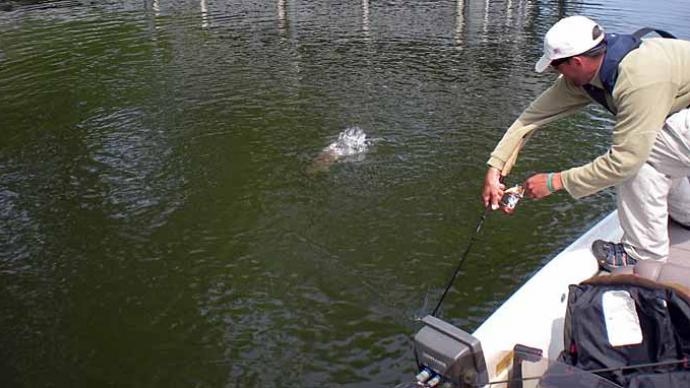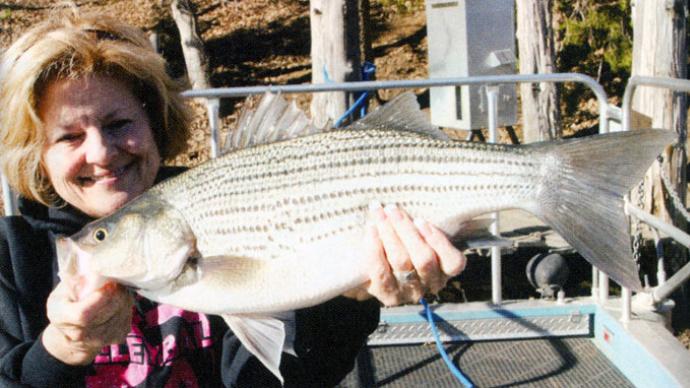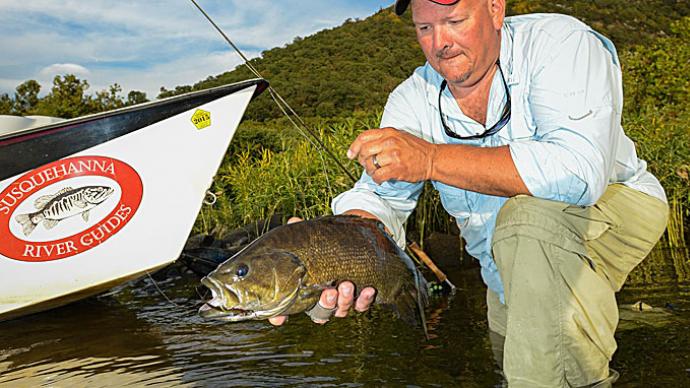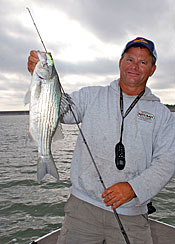
Black bass are hands down the most popular game fish in the country. There’s some debate about whether largemouth or smallmouth bass are number one. Largemouth bass have their following from south of the Mason-Dixon Line, and smallmouth reign with anglers who ply the Great Lakes and northern reservoirs. Honestly, this is a debate where there are no losers.
Other bass species don’t get nearly the fanfare their black cousins do. White bass and wipers don’t get nearly the attention that largemouths and smallmouths do, but they deserve mention. They’re readily available in many parts of the country, smack a lure with a vengeance, are incredibly active during the heat of summer, and limits are generous if you want to take some fish home to eat.
I’m not sure why anglers tend to look down on white bass. As they are sometimes called, silver bass scrap as much as a largemouth and hold their own against all but the most pugnacious smallmouth. Places where anglers look at white bass as second-class citizens are destinations with plenty of species such as trout, salmon, black bass, and walleye that are looked upon with great esteem. White bass have saved many a day for anglers scorned by these more glamorous species.
White bass and wipers are very active when some species become hard to catch during the summer doldrums. The one time anglers seem to target wipers, and white bass is in the spring. Both whites and wipers make spawning runs up rivers in the spring from the reservoirs and lakes that they inhabit the rest of the year. The fish are highly concentrated then, and some anglers take advantage of the spawn to catch big numbers of both species.
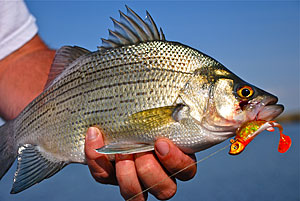
Once the spawn is completed, these bass return to the big water. There they disperse to chase pelagic schools of shad and alewives. They aren’t as easy to find as largemouth or smallmouths because they don’t relate to structure or shorelines and usually shadow nomadic baitfish schools.
Finding schools of white bass and wipers has become easier with the advent of side imaging technology found in electronics units like Hummingbird’s Helix SI GPS. Besides side imaging, this unit has down imaging, mapping, and 2D sonar for under $500. Even the small-boat angler can use it to score big on whites and wipers.
But don’t rely totally on your electronics when searching for the other bass. Use your eyes, too. Watch for schools of whites breaking the surface when chasing schools of bait or terns and gulls diving on the schools to partake in the malady. In lakes and reservoirs with both species, white bass can often be seen thrashing the surface while the larger wipers wait below the silver bass schools.
The great thing about whites and wipers is that when the weather is sweltering, the fishing is the hottest. My friend Burt Harris and I had a chance to join guide Steve Lytle on Swanson Reservoir during the peak of an annual hot spell. The reservoir was down close to eight feet below average, and the sultry summer heat wave had heated the water to the temperature of bath water. Lytle told us not to worry because the white bass were still biting.

Lytle’s go-to bait for white bass is one of his designs called Lytle’s Secret Tail Spinner. It is a heavy ¾- to 1-ounce lead-bodied bait with a large Colorado spinner blade on the back. The versatile bait can be jigged, yo-yoed, hopped, or retrieved on a steady retrieve. Lytle told us to cast as far as we could, let the bait sink for a few seconds and then begin our retrieve. We were positioned far from shore over a couple of humps in 11 or 12 feet, or water where the bass were herding shad.
Burt’s first cast produced about a 15-inch white bass, as did his second, third, and fourth. Each bass brought to the boat had a half dozen others following it.
“I must not be holding my mouth right,” I joked to Burt as he reeled in another silver bass. I knew it was just a matter of time. Soon I got on the board, and then it was a free-for-all with all three of us fighting white bass simultaneously.
After I’d caught about six white bass, something slammed my Secret Tail Spinner that didn’t feel like a white bass. It peeled line off my reel and bored for the bottom.
“Wiper!” came Lytle’s immediate reply. The fish was strong and reminded me of a Chinook salmon I’d caught in Michigan. The striped bass/white bass hybrid was about 8 pounds and had the classic broken lateral lines that denoted a wiper.
Lytle changed gears to target the hybrids, knowing that wipers were mixed in with the white bass or schooling just below. One way to discourage the white bass was to use bigger lures. Lytle had three rods rigged, each with a different lure to appeal to the wipers. A rip and flutter retrieve with a 5-inch ProSwim Eye2Flutter spoon triggered strikes from hybrids higher in the water column preying on injured shad.

Another bait made by ProSwimbait.com, a 5-inch ProMinnow Swimbait, has a lifelike shad outline and feel and a vibrating tail to cover the mid-depths. Lastly, Lytle would pick up the deep-diving Strike King Pro Model 5XD and 6XD Series crankbait every once in a while to dredge the bottom. Each lure produced a good wiper within a couple of casts.
The white bass continued to hit everything we threw at them until we lost count of how many we caught. At least ten times, all three of us had white bass and/or wipers on simultaneously! That night, Burt admitted that his arm was kind of sore. No wonder with non-stop action like that. Lytle said it’s not uncommon to catch over 100 white bass and wipers on Swanson. We easily topped that total and added a limit of walleye, several good largemouths, and a dozen crappies to the catch.
White bass and wipers are not as good to eat as walleyes or crappies, but they are palatable if you handle them properly. One thing you need to do is ice them down immediately after catching them. Do not leave them on a stringer, or they’ll tend to be strong flavored, soft, and mushy. Clean them as soon after catching them as possible. Fillet and skin them and trim all of the dark meat away from the lateral line. The dark meat contains most of the strong flavor associated with white bass and wipers. For the best flavor, cook the fish as soon as possible without freezing them.
White bass and wipers can be found all across the country and especially in the Midwest, Great Lakes, and Great Plains. While they’re not as highly regarded as some species, they sure put a bend in your rod when other more glamorous species are sulking.


